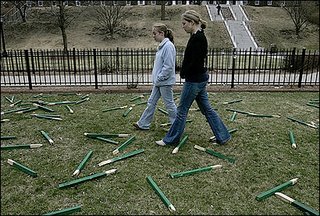Whether you call it an “illegal war,” “bringing democracy to the Middle East” or “the front line of the War on Terror” it’s an armed conflict.
As in any armed conflict there are three groups involved, and each group has a portion that are injured or killed by the conflict. The groups involved are the respective combatants, and everybody else caught in the middle.
In “insurgencies” or other guerilla wars it is hard, or impossible, to reliably separate the combatants in the non-uniformed forces from the mass of the “caught betweens.” It is even harder to separate the casualties.
It is harder still to examine what the “fortunes of war” have wrought if the civilians and non-uniformed combatants are not counted, either because it is too difficult to count and estimate or because it is a matter of policy to not count, or to purposely underestimate the numbers.
Last week some students at The College of the Holy Cross, in Worcester (Massachusetts) decided to try to bring a graphic reminder of the costs, in lives, of the “insurgency” in Iraq, and hopefully start a dialog about what is being bought with the lives of the combatants involved and the people caught in between.
 With the permission of the College’s administration, and a warning from that same administration that vandalism might be possible, last Thursday (03/31/06) two sophomores at the College, Sarah Fontaine of Somers, CT and Molly Hoagland of Portland, OR (both seen in the photo at left) organized an “installation” of 1026 stakes, some painted green, some white, placed into the earth in the quadrangle outside the main dining hall. Each stake is meant to represent 100 deaths in the war in Iraq.
With the permission of the College’s administration, and a warning from that same administration that vandalism might be possible, last Thursday (03/31/06) two sophomores at the College, Sarah Fontaine of Somers, CT and Molly Hoagland of Portland, OR (both seen in the photo at left) organized an “installation” of 1026 stakes, some painted green, some white, placed into the earth in the quadrangle outside the main dining hall. Each stake is meant to represent 100 deaths in the war in Iraq.A white stake represents 100 American casualties; a green stake represents 100 Iraqi casualties. 26 of the stakes are white. The remainder are green.
A stark and graphic reminder of the costs to the people of Iraq of the present conflict.
The two students conceived of the installation as a way to start a more open discussion over the personal cost of the war among the 2700 students at the College.
However, sometime over Friday night the stakes representing the Iraqi dead were pulled up out of the ground and strewn about the quad, and the signs explaining what the stakes represented were destroyed, and in their place a Unites States flag was draped over a fence and a sign was posted saying “Freedom is not free.”
Rather than re-erect the green stakes, the organizers instead opted to pull out the white stakes and mingle them with the scattered green, an installation that is as effective as when they were all in neat rows. The contrast of the white separated from the green will not be as stark, but the symbolism of the commingled fallen is very powerful.
To my own mind, two of the more striking thoughts to come from the vandalism are that there are those who feel the U.S. dead are a priori more important than the Iraqis who have died, and the question of who is paying the price for whose “freedom.”
If those who vandalized this installation truly *do* think that the U.S. lives are more important than the Iraqis, then why do they support our troops being there at all, and why are we, as a nation, paying the blood price of our own dead for those who are not as “worthy?”
The more general questions of disrespect for independent thought, and the cowardice of those who would do this under the cover of darkness, I leave to the reader.
However, the installation, and the vandalism, have been effective at stimulating the desired dialog within the student body, and the reaction to the vandalism may be even more of an impetus for that discussion than the installation on its own.
Coverage of the vandalism by the Boston Globe is here, coverage by the Worcester Telegram & Gazette is here.
No comments:
Post a Comment